The Princess & Lady Luck
“Remember it’s all luck.
… understanding that you can’t truly take credit for your successes, nor truly blame others for their failures will humble you and make you more compassionate.”
Tim Minchin, UWA graduation address, September 2013. Watch the entire thing on Speakola.
Congratulations. Well done. Great work. The sorts of things that birders say to each other all the time. But what do we mean by these things?
I’m just back from co-leading and driving for Mark Carter Birding & Wildlife’s Princess Parrot Expedition into the deserts west of Alice Springs. I’ve driven countless hundreds of thousands of kilometres through these deserts over the years, and I love it. The driving that is. A lot of people see driving as the unfortunate chore that must be endured to get to the places we go to look for birds, but I’ve always found it as much a part of the appeal of birding as the cheese scones and coffee-breaks. Driving, particularly, I would argue, in the desert, is cathartic. It’s great time to ruminate on things. If you’re fortunate enough to have pleasant travelling companions, it is the perfect opportunity to chew over ideas and hear a few stories from other peoples’ lives.
So I got a lot of thinking done on this trip.
The stark honesty of outback road signage.
Mostly, I got to thinking about luck. There’s something in Tim Minchin’s shared nugget of wisdom that I think birders, all of us at one time or another, tend to gloss over. Despite the hackneyed image of the conventional birder as something of a swot – studious, scholarly, minutely researched – there is a central role for luck in the pursuit of wild things. Good fortune, malesh, kismet; call it what you like. It can’t be denied.
Perhaps we tend to put it to one side because when we find a bird, we want to be able to suggest that it was our superior understanding of the bird’s relationship to its habitat that led us to it. Or perhaps it was our peerless vision, knowledge of bird behaviour and plumage characters that enabled us to pick it from a vast flock of similar birds. Without a doubt, that is certainly the case some of the time. Perhaps even most of the time.
There are some species that are site faithful and fussy about the type of habitat they will occupy and foods they will consume. So if you’ve done your reading and have the chops to distinguish healthy habitat from disturbed in the field, then maybe you really can target and track down a bird. If you’ve got the eyes and the experience behind a scope to pick a lone Little Stint from a flock of 10,000 Red-necked Stint, you have my admiration and it would be only a curmudgeonly fool that would deny your skill. But even then… if there isn’t a vagrant Little Stint in the flock you can look all day and see nothing but Red-necked Stint, so there is still an element of luck. We can all agree, however, on the clear difference between that scenario and some duffer walking into his mate’s back yard to stumble on a Forest Wagtail. Whatever that duffer’s knowledge of the species may be, he didn’t truly find the bird did he? If anything, the bird found him; or perhaps they met each other halfway. Such is the nature of many vagrant ‘finds’. While the above scenarios might fairly be described as great finds, the latter is probably more accurately termed a ‘discovery’.
Where does that leave other species that aren’t vagrant, may not even be rare, but are yet nearly impossible to find? Perhaps a species that might be nomadic? What about a species that has a massive possible (or actual) home range that exists entirely within remote and difficult terrain? By now you can see where I’m headed with this.
Just for once, I’m not on about the Night Parrot either. But as you bring it up, it illustrates the point about luck quite neatly doesn’t it? Very few people have had anything but the most profuse praise for John Young’s tenacity, skill, patience, and hard work in tracking down that bird. But in acknowledging that, we also have to acknowledge (and John has said as much in his many talks) that there were numerous strokes of luck along his journey of discovery as well – feathers on the wire, the dead specimens, being in the right spot to hear and record that historic first call. It’s the ultimate intersection of skill and good fortune.
But the other side of that coin is just as undeniable. There were several, if not dozens, of similarly talented, highly skilled and educated researchers, bushmen and ornithologists out in the field and poring over maps and papers at home or in museums and laboratories, across the outback and around the country, looking for the Night Parrot and what did they come up with?
Zero. The centre of a doughnut.
"There's no grip here; just a dip that'll make you wish you were born a herper."
Are they all just hacks and duffers? All of them? Surely not. In fact, among them are some of our most senior arid-zone ecologists, including some who are now in the thick of it, participating in the ongoing research into that species. Despite all their experience, study, bushcraft and years spent scouring the bush, they just didn’t have luck on their side.
But before we disappear up our own fundaments in a maelstrom of epistemology, there's a piece of wisdom that Mr. Minchin failed to pass on. For every neat aphorism there is an equally tidy and contradictory platitude. Some of you will already have thought of a pertinent one here. You make your own luck. Yes indeed. Through hard work, diligent study, astute networking and imaginative connection of apparently disparate data, you may increase the likelihood of success in various endeavours. But, again, we’ve covered this. Life isn’t fair. History is filled with talented, hard-working, deserving people who had all the facts and still just missed out.
So we have to acknowledge the role of luck in our successes and our failures.
This is a concept we need to popularise in birding. Despite the swaggerish title of this blog, anyone who has met me will vouch that it was chosen in the most ironic spirit of self-deprecation. The whole idea of the birding grip off is, I hope, clearly farcical and best reserved for use only amongst the very best of friends. You can scour your Dolby & Clarke and pick apart your Thomas & Thomas but in the end, with a nod to the caveats discussed earlier about identification of healthy habitat and the like, finding birds has as much to do with good fortune as your knowledge of the field guide. If you’re prepared to contest this, you should take care; you may be leaving yourself wide open to public ridicule every time you dip. And there will be many dips. Oh yes. There will be dips.
A natural born Dipper.
What has any of this got to do with Princess Parrots, I hear you ask? I’m glad you brought it up. My central thesis is this: nobody finds Princess Parrots.
The distribution map for Princess Parrot from the Department of the Environment. Easy, just look in the red bit right?
There’s a pernicious rumour that the Princess Parrot falls into that class of birds that, with the right knowledge, equipment and your jaw set at the right angle to depict heroic and imperturbable single-mindedness, you may go forth into the wilderness and find. Furthermore, there is a wild fantasy harboured by some in our midst, that one can just nip out to Neale Junction or Jupiter Well and catch them dozing in the Desert Oaks. It's a simplistic 'just add water' approach to arid land birding. To the more sober among you, this is as ludicrous as it sounds. Nonetheless, I feel I would be remiss if I didn’t attempt to disabuse you of this illusion.
As I wrote earlier, I recently ‘nipped out’ to Jupiter Well with Mark Carter and a small party of Australian listing heavy-hitters to give them a chance at ticking off this Australian-breeding mega. Truman Capote once wrote that, “…failure is the condiment that gives success its flavour”. If that’s so, then this was a tasty trip, and not just because of Mark’s form at the camp oven. (The man lived two years in North Africa and evidently picked up a thing or two about knocking together a fierce lamb tagine.) The abridged version: in 7 days ex-Alice Springs, spent fudding about Jupiter Well, Lake Mackay and parts west, we didn’t see a single Princess.
The trip was meticulously planned. As the mad bastard who conceived of this trip in the first place, all credit for that planning has to go to Mark. We received exceptional permits to camp in the region and head off-track to get up to Lake Mumu (freshwater) and Lake Mackay (salt and at the time, dry). These permits were a critical difference between this trip and most other visits to the area, and took a good deal of organising. A transit permit is required to traverse the Gary Junction Road, but this is precisely as it sounds – a permit to pass along the road corridor and nothing else. Technically, stopping for anything other than answering the call of nature is against the conditions of the permit. Certainly it doesn’t permit camping anywhere along the road. So, the Gary Junction Road transit permit limits you to a single crack at Princess Parrots in the vicinity of Jupiter Well, then you have to continue on your way.
We also had permission to head off the Gary Junction Road to investigate the localities of other recent sightings of the species, away from Jupiter Well. The most recent sighting that we were aware of was Richard Waring’s encounter with 19 birds on the Gary Junction Road near Walangurru (Kintore, NT) in April 2015.
Other than that, there really wasn’t a lot more to go on. It was a bold move by Mark to put on a trip seeking such a notoriously unreliable bird. Everyone on both sides of wildlife tourism knows full well that there are never guarantees, but from the guide’s perspective there is still an immense amount of pressure and a deep sense of obligation to show people everything they hope to see.
From fairly early on in the trip it was clear that conditions were dryer than we had anticipated. Insectivores were everywhere. We saw some very large mixed flocks of Masked and White-browed Woodswallow in association with a moth emergence. In the same area we were counting White-winged Triller by the hundred as they passed through following abundant swarms of insects. We saw groups of Varied Sittella, usually a very unreliable bird in Central Australia, at almost every place we stopped to bird. But granivores were all but absent. A few Zebra Finch flitted here and there if water was at hand, the occasional small mob of Budgerigar ripped through overhead, but that was about all we saw from the seed-eating guild.
Despite passing through some of the most extraordinarily well-managed spinifex sandplain that Mark or myself had ever seen, there was just nothing eating seed. It didn’t bode well for parrots. The mornings and late afternoons were spent at listening posts hoping to pick up the distinctive sounds of The Princess, or slow-cruising tracks interrogating every Desert Oak and Bloodwood. During the warmer part of the day we covered more distance and investigated a few different habitats. We walked some dune fields, checked out leaky water tanks and open water sources and scoured the horizon until we went cross-eyed. If there were Princess Parrots in the area, I’m confident we would have seen something. With so much time in the area, with so many pairs of eyes and ears set to the task – we’d have seen them if they were there. My own feeling is that they just weren’t in the area.
So to the painfully obvious question – where are they?
If they were out there, they certainly weren't showing themselves.
If anybody knows, they aren’t saying. If you look on a map you’ll see that Jupiter Well and Neale Junction, the two most routinely cited ‘occasionally reliable’ locales for the bird, are not actually that far to go. The usual precautions for remote travel in desert regions apply, but with the right car, communications gear and the right attitude you actually almost can ‘nip out’ from Alice Springs to Jupiter Well. It’s really only one big day of driving to get out there (and a similar trip from Kalgoorlie to Neale Junction in WA). It’s by no means a doddle but it’s within the capabilities of any birder with outback driving experience. If there were birds out at Jupiter Well with anything approaching the reliability that the birding grapevine might suggest, there would be carloads of birders departing Alice Springs every single weekend. The fact that there isn’t, says everything we need to know.
It’s no exaggeration to say that, with the wild ecology of the Night Parrot all but ‘in the bag’ thanks to John Young and the ongoing research being conducted by the team at “The Queensland Site”, the movements of the Princess Parrot is a strong contender for the title of Australian ornithology’s new holy grail. How you go about researching a bird that moves with apparent ease across such a large chunk of the continent will be decided by someone smarter than me, but if I had to guess I suspect it’ll come down to another John Young-style effort. There are few hi-tech approaches that seem likely to yield results. An individual or small team driving the country confirming presence or absence at various points and making feeding and breeding observations seems as good an approach as any. The literature on the species is sparse and we can only hope that an individual or institution will step up soon to fill in the blanks.
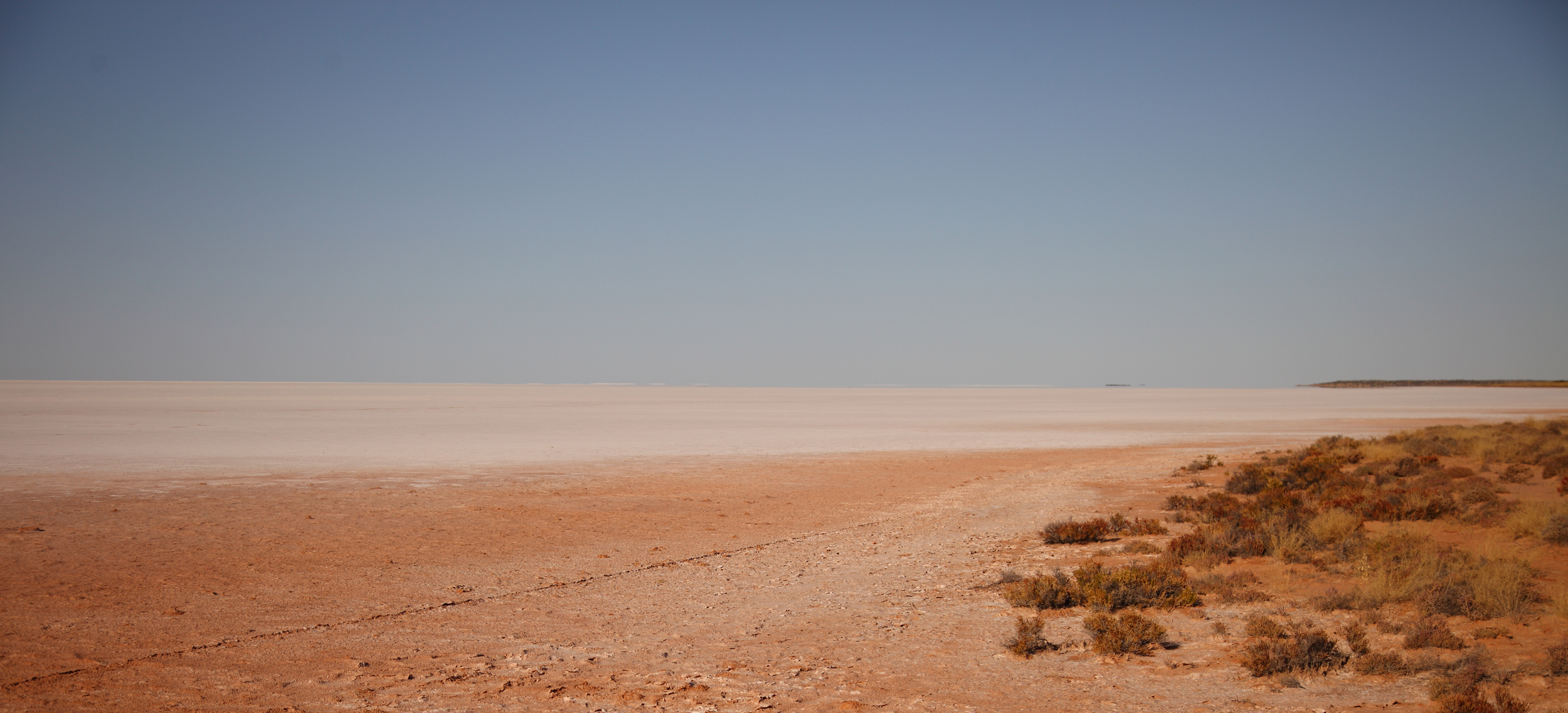
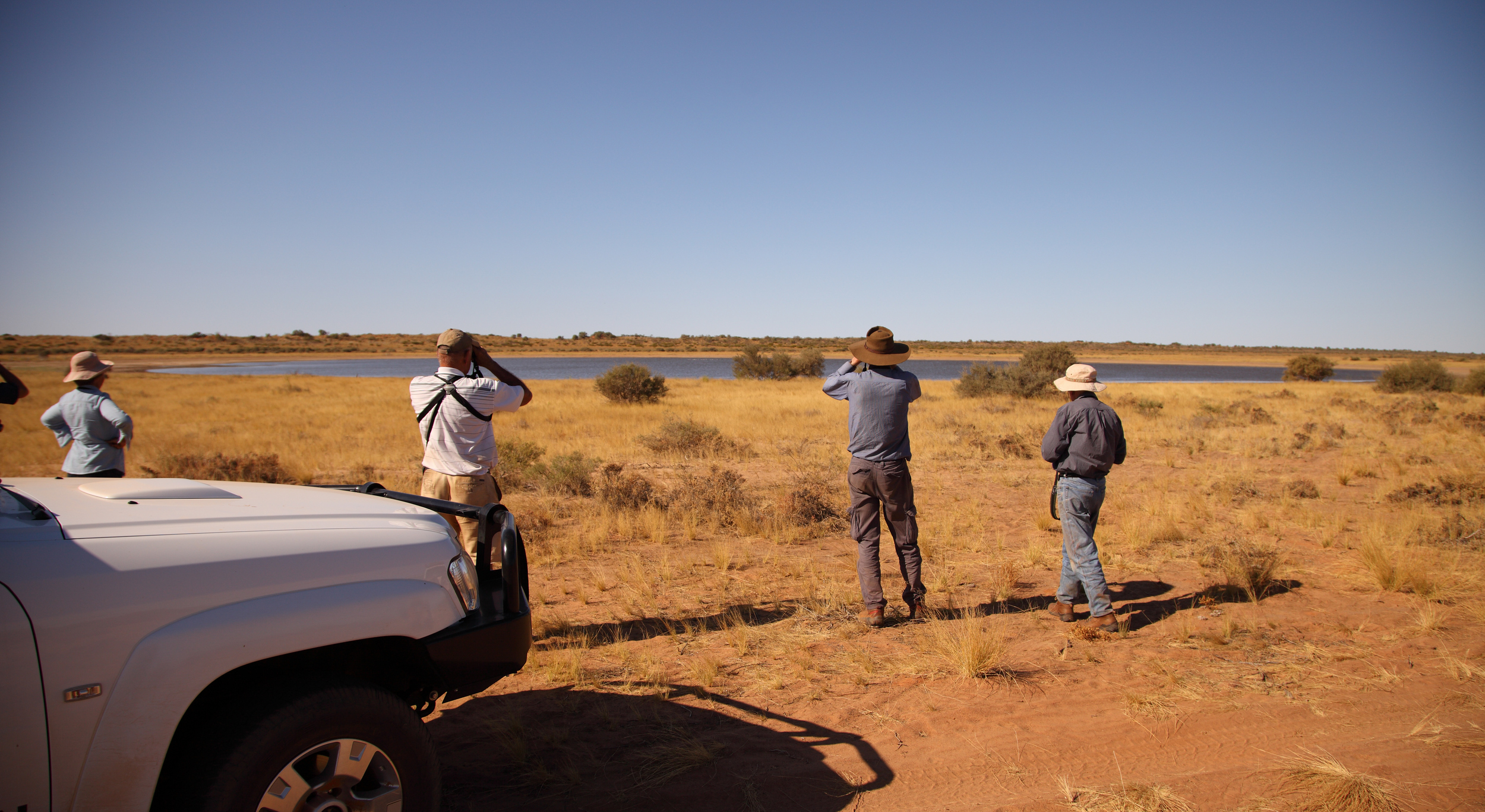
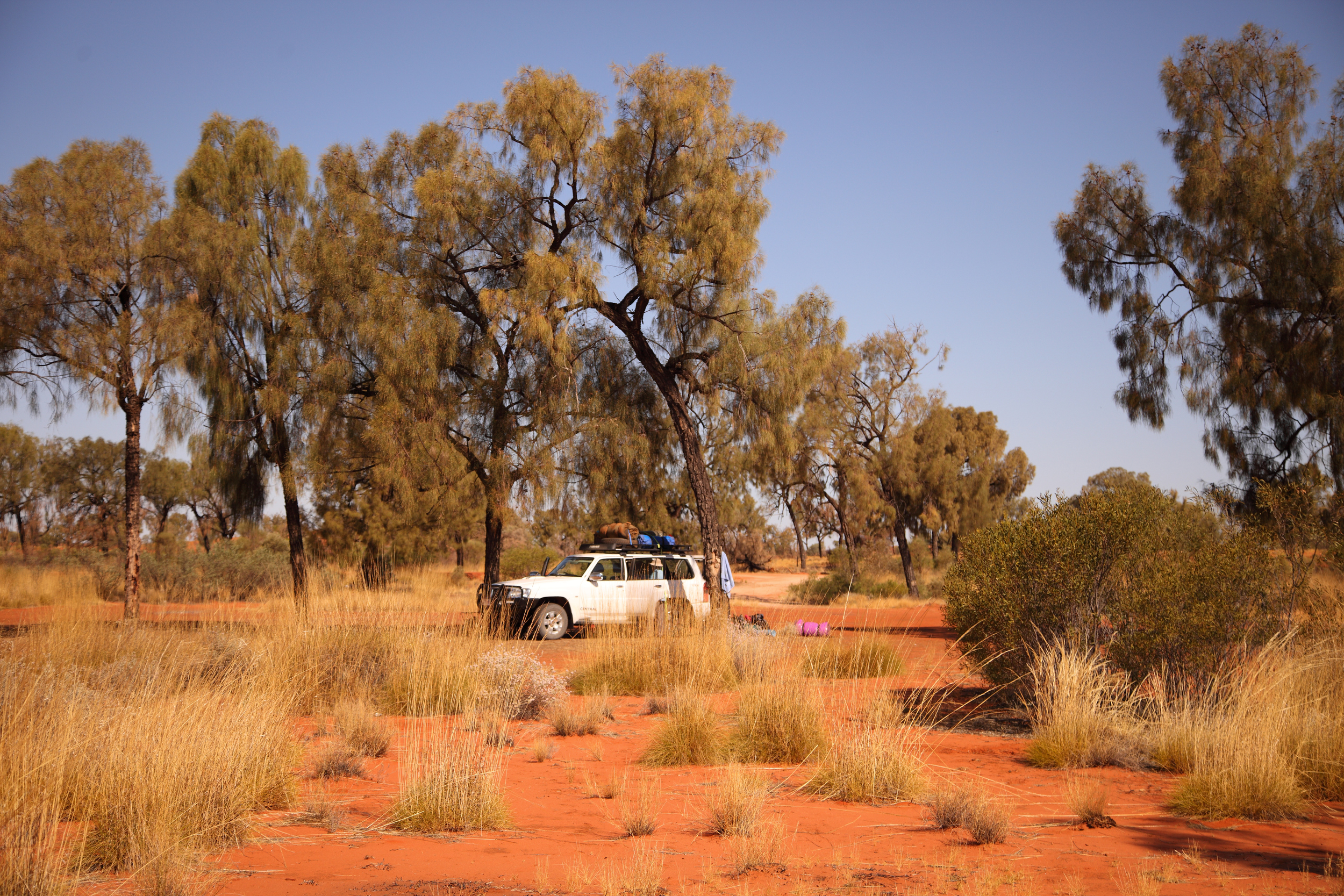
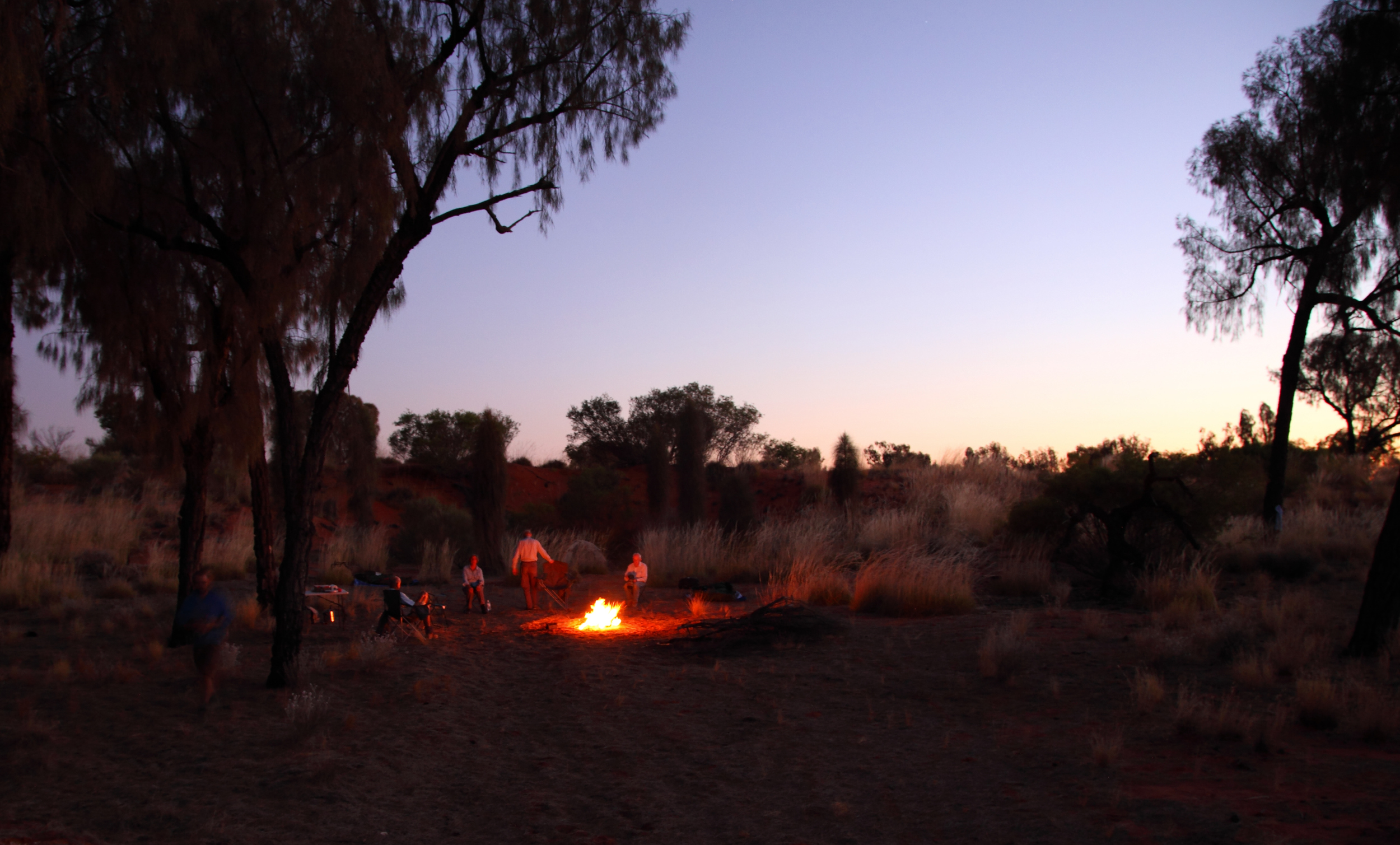
So we missed The Princess, but as Jack Black’s character in The Big Year says at the end of the eponymous travails, “…we got more. More… everything”. It was extraordinary and life-affirming just to be out there amongst it. It’s a very new-age, Dennis Denuto sort of sentiment, but it really is the vibe of the thing. Setting off into the desert on a wildly ambitious adventure of pure discovery, could hardly have been more exciting and the results more edifying. Only the cold and dead of heart could have felt otherwise. We saw parts of the desert that even seasoned travellers of the arid lands have never visited. We slept in the soft sand amid whispering Desert Oaks – the wind harps of the Western Desert. We spent perfect, still mornings birding among thronging flocks of feeding woodswallows, chats, and trillers. We saw Brolga reflected in the disc of a freshwater lake between red sand dunes with the sun setting on our backs. We stood on the shores of Lake Mackay, an expanse of salt rivalled in size by few others on the continent and seen by few non-indigenous visitors since the days of Warburton, Giles and Beadell. We tracked the wanderings of innumerable nocturnal mammals across the sand in the crisp mornings. We encountered iconic desert wildlife like Thorny Devil and the endangered Centralian Carpet Python.
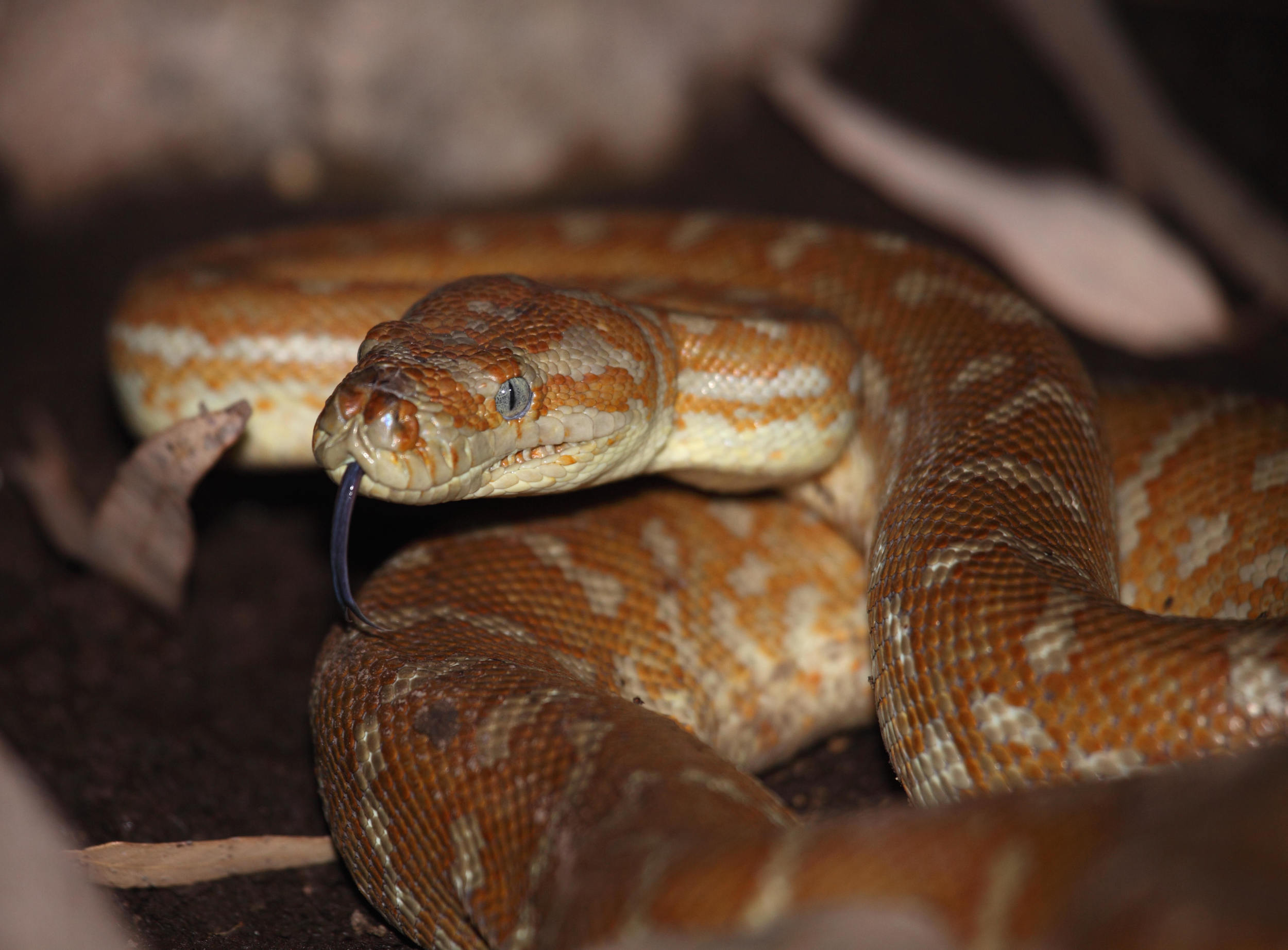

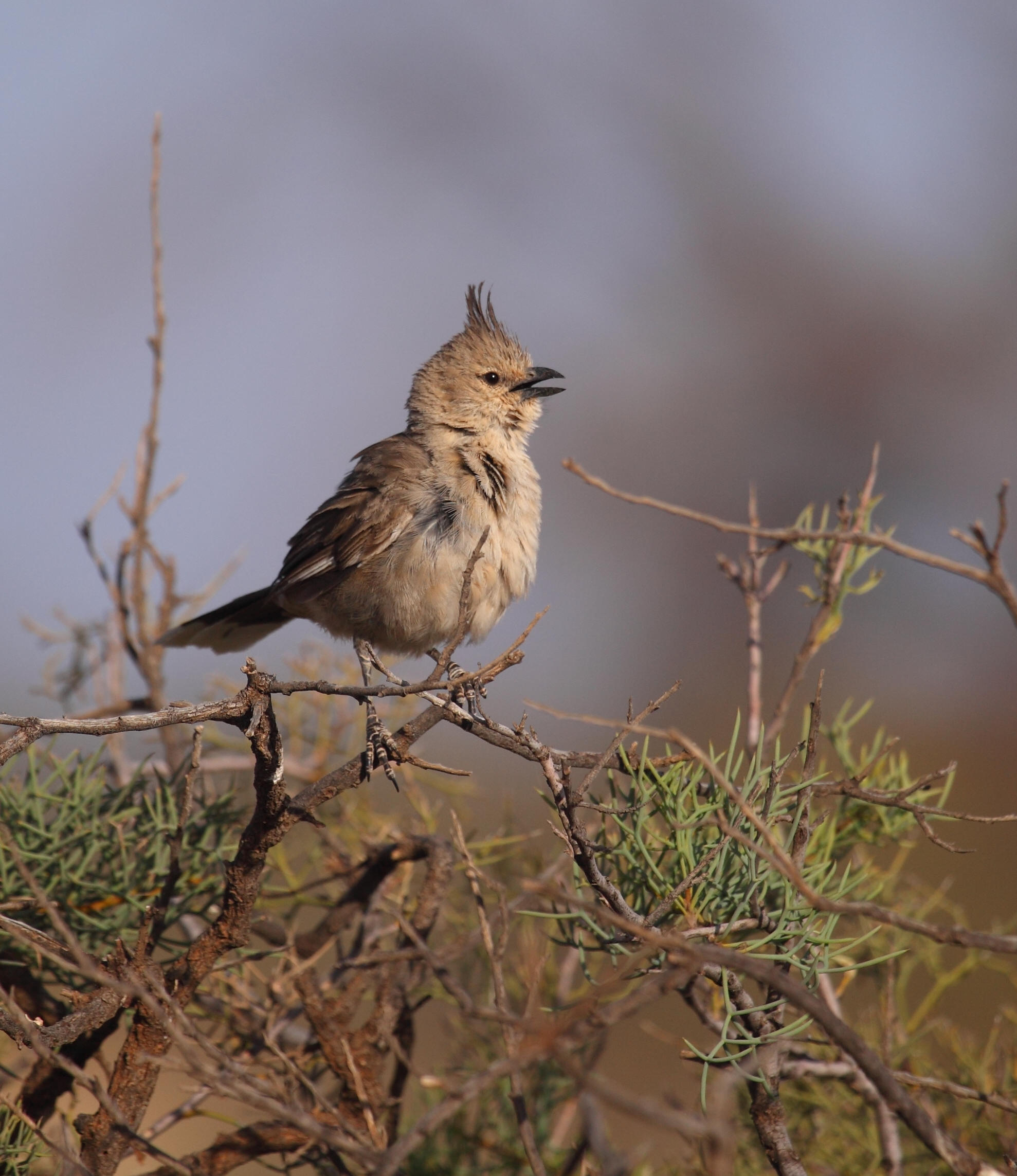
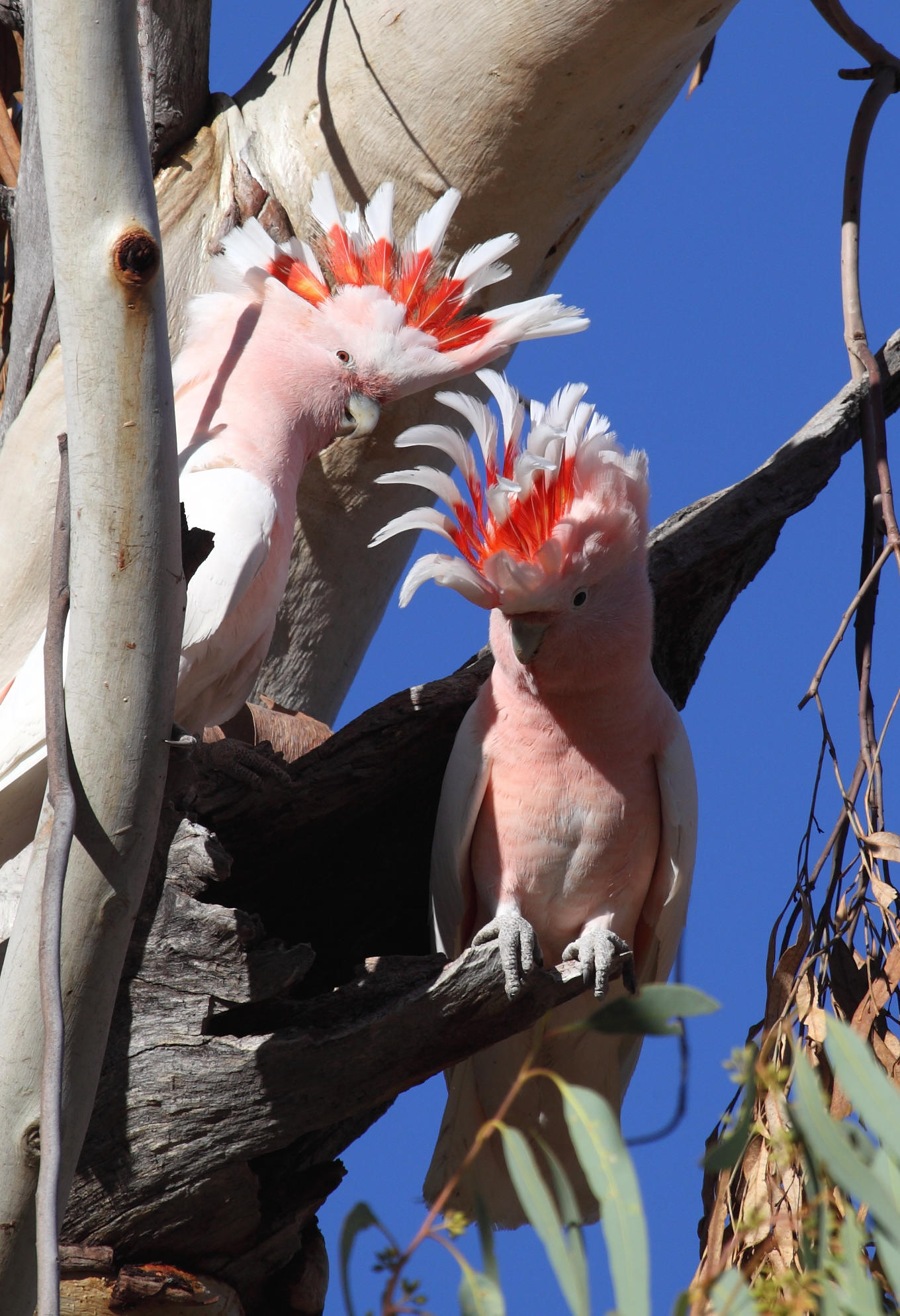

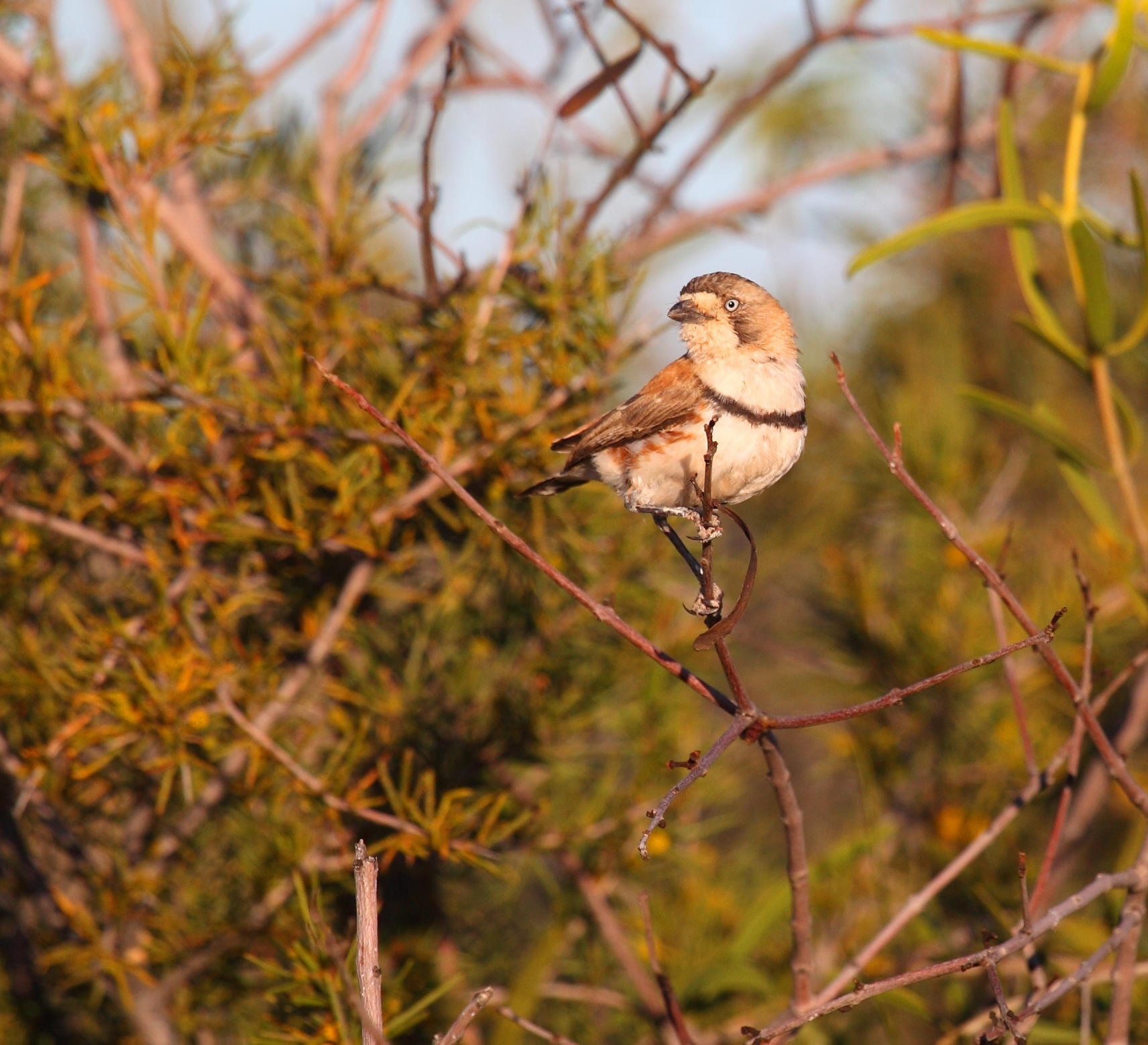
Atop all of this, during a fairly dry and quiet period in the desert life-cycle, we still managed to see more than 100 species of bird including cripplers like Banded Whiteface, Sandhill Grasswren, Chiming Wedgebill, Crimson and Orange Chats, Painted Finch, and Major Mitchell’s Cockatoo.
It’s a big list, with a lot more than just a parrot-shaped hole.
It’s a list to be proud of, despite the parrot-shaped hole.
*****
A short, meandering postscript. In seven days of driving there are a lot more thoughts that can be neatly summarised in just a few hundred words.
As well as the nature of luck and its relationship with birding, another common topic of energetic conversation in my car was the obvious, but rarely mentioned, relationship between scientific discovery and commerce. Exploration has often been funded by wealthy benefactors or sponsors. Increasingly, we can cast wildlife-seeking tourists in this role without fear of overstating things.
There was a time, not all that long ago, when pelagic trips leaving Australian shores were a pretty specialised and exceptional event. In recent decades this has been changing gradually and now there is barely a weekend that goes by without pelagic trip reports from one or more trips reaching our inboxes. While these trips are still mostly costed so they reach the break-even point rather than generating serious profit, it is the patronage of birding tourists that keeps them going. Our understanding of seabird diversity in Australian waters has increased along with the frequency of pelagic birding trips. Anyone who has been on these trips can attest that the organiser/leader is usually someone with a deep knowledge of pelagic wildlife and a keen interest in the collection of data. This is as clear an example as you could want of tourism directly providing the means for data collection and scientific research. We pay to get out to the shelf and see some albatross and petrels and an inquiring mind is provided with the means to get into the field and access the populations they need to observe and sample to further our collective understanding. It’s a beautiful thing.
It’s not limited to pelagics either. Anyone who has birded in Africa or Central or South America is likely to have encountered numerous examples of local communities supplementing (and even replacing altogether) sometimes destructive subsistence industries with the income provided by wildlife tourists to see preserved habitat and the specials animals within it. Angel Paz and his extraordinary knack for habituating various species of Ecuadorian antpitta, springs immediately to mind. Whatever your stance on feeding wild birds, Angel has become deservedly famous for rendering once near-invisible birds, accessible and easily-viewed for paying visitors to his cloud-forest reserve, which may otherwise have been levelled long ago for crop-farming. How would you go about seeing lekking Andean Cock-of-the-Rock if it weren’t for the numerous protected stake-outs of known lekking sites for this astonishing species?
It’d be good to see an elevated and enlightened discourse develop around professional bird and wildlife guiding in Australia. Professional bird guides in Australia have often been on the receiving end of some fairly thoughtless and small-minded criticism in the past. This is by no means prevalent, but common enough to be troubling. Just as pelagic trips have drawn back the curtain on pelagic wildlife in Australian waters, there are a number of exceptionally talented and highly-skilled individuals who have been doing the same on terra firma.
Whether it's pelagics on the blue paddock or expeditions inland, someone has to go looking or we never learn anything.
Particularly to those who have pioneered the difficult business of inland birding, we owe a great deal of thanks. The birds are hard and the country even harder but the rewards are obvious. It’s a staggeringly large continent that we live on and there are still many, many blanks on the map. Mark Carter is by no means the only guide offering birding trips in our vast deserts, but it took chutzpah to take on a bird like the Princess Parrot – the sort of chutzpah that will inevitably pay dividends. Diamonds owe their value to their scarcity and this is just as true for birds like this. An encounter with the bird is priceless, but even to search for it brings ineffable rewards. If I had my way, Mark would be rewarded with a flood of inquiries for subsequent trips. Trips like this are the beginning of understanding. In an age where dedicated research funding is as elusive as some of the animals it might be spent studying, citizen science and tourist-funded expeditions are where we will get our baseline data.
SPECIAL THANKS
No expedition of this nature comes together without help from many quarters. The country we visited looked fantastic and credit must go to Traditional Owners and ranger groups for their efforts managing this large area. The country is administered by the Ngaanyatjarra Council and their staff were helpful at every step of the permit application process. The wonderful folks running the store at Kiwirrkurra were always smiling and welcome, despite our regular demands for fuel and service at irregular times - thanks a million, you should all know how important you are to regional tourism. And the same goes to the friendly folks at the store at Watiyawanu (Mt. Leibig).
Thank you all - your blood's worth bottling.
Species Lists
Birds (in roughly the order seen)
- Magpie-lark
- Galah
- Spiny-cheeked Honeyeater
- Little Crow
- Black-faced Cuckooshrike
- White-plumed Honeyeater
- Yellow-throated Miner
- Willie Wagtail
- Pied Butcherbird
- Zebra Finch
- Black Kite
- Black-breasted Buzzard
- Whistling Kite
- Rock Dove
- Australian Ringneck
- Crested Pigeon
- Singing Honeyeater
- White-winged Triller
- Peregrine Falcon
- Brown Falcon
- Collared Sparrowhawk
- Black-faced Woodswallow
- Crimson Chat
- Black-chinned Honeyeater
- Grey-headed Honeyeater
- Australian Hobby
- Western Gerygone
- Red-backed Kingfisher
- Rainbow Bee-eater
- Australian Magpie
- Crested Bellbird
- Rufous Whistler
- Chiming Wedgebill
- Banded Whiteface
- Australasian Pipit
- Red-browed Pardalote
- Little Button-quail
- Variegated Fairy-wren
- Australian Bustard
- Striated Pardalote
- Black-shouldered Kite
- Budgerigar
- Varied Sittella
- Rufous Songlark
- Weebill
- Major Mitchell's Cockatoo
- White-backed Swallow
- Masked Woodswallow
- White-browed Woodswallow
- Diamond Dove
- White-necked Heron
- Mistletoebird
- White-fronted Honeyeater
- Black Honeyeater
- Little Eagle
- Brolga
- Red-necked Avocet
- Sharp-tailed Sandpiper
- Orange Chat
- White-winged Fairy-wren
- Sandhill Grasswren
- Brown Goshawk
- Red-capped Plover
- Nankeen Kestrel
- Spotted Harrier
- White-faced Heron
- Australian Reed Warbler
- Black-fronted Dotterel
- Grey Teal
- Wedge-tailed Eagle
- Great Egret
- Tree Martin
- Ground Cuckooshrike
- Hooded Robin
- Little Grassbird
- Hoary-headed Grebe
- Australasian Grebe
- Tawny Frogmouth
- Little Pied Cormorant
- Australian Spotted Crake
- Australasian Swamphen
- Southern Boobook
- Eurasian Coot
- Southern Whiteface
- Grey-crowned Babbler
- Yellow-rumped Thornbill
- Mulga Parrot
- Pink-eared Duck
- Grey Shrike-thrush
- Dusky Grasswren
- Painted Finch
- Western Bowerbird
- Inland Thornbill
- Slaty-backed Thornbill
- Red-capped Robin
- Splendid Fairy-wren
- Spinifex Pigeon
- Masked Lapwing
- Australian Owlet-nightjar
- Sacred Kingfisher
- Brown Honeyeater
- Little Woodswallow
- Grey Fantail
- Fairy Martin
Reptiles
- Gehyra purpurascens
- Bynoe's Gecko
- Sand-plain Gecko
- Carlia triacantha
- Blue-tailed Ctenotus
- Centralian Blue-tongue
- Long-nosed Dragon
- Central Military Dragon
- Central Netted Dragon
- Thorny Devil
- Central Bearded Dragon
- Spiny-tailed Monitor
- Pygmy Desert Monitor
- Gould's Sand Monitor
- Centralian Carpet Python




